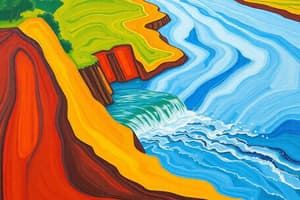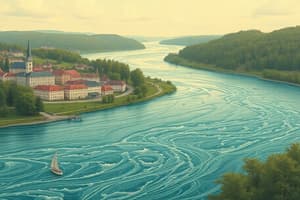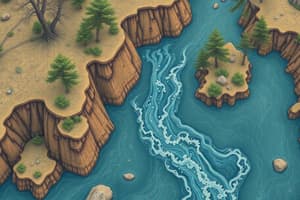Podcast
Questions and Answers
When did the 1955 flood in the city happen?
When did the 1955 flood in the city happen?
- Easter Sunday
- Christmas Eve (correct)
- New Year's Eve
- Thanksgiving Day
What is placer gold?
What is placer gold?
- Gold found in rivers (correct)
- Gold found underground
- Gold found in mines
- Gold found in mountains
What is lode gold?
What is lode gold?
- Gold found in mines (correct)
- Gold found underground
- Gold found in rivers
- Gold found in mountains
What can be seen from Google Earth in the area?
What can be seen from Google Earth in the area?
Which factor influences the velocity and discharge of a river?
Which factor influences the velocity and discharge of a river?
Where can gold be found in a river?
Where can gold be found in a river?
What is the role of discharge in a river?
What is the role of discharge in a river?
Which river has the highest discharge in the world?
Which river has the highest discharge in the world?
What caused the barren mountains in Weaverville, California?
What caused the barren mountains in Weaverville, California?
What is the average velocity of water at the mouth of a river compared to the head?
What is the average velocity of water at the mouth of a river compared to the head?
What is the discharge of the Oroville Dam during the spillway incident?
What is the discharge of the Oroville Dam during the spillway incident?
Why does the Nile River have a lower discharge despite flowing near the equator?
Why does the Nile River have a lower discharge despite flowing near the equator?
Which river is being discussed in the text?
Which river is being discussed in the text?
What is the highest mountain in California?
What is the highest mountain in California?
What is the purpose of a dam in a river?
What is the purpose of a dam in a river?
Which characteristic increases downstream in a river?
Which characteristic increases downstream in a river?
What causes a river to stop eroding and reach base level?
What causes a river to stop eroding and reach base level?
What type of valleys are formed in the headwaters of a river?
What type of valleys are formed in the headwaters of a river?
What is the longitudinal profile of a river?
What is the longitudinal profile of a river?
What happens when the land around a river is pushed up due to tectonic processes?
What happens when the land around a river is pushed up due to tectonic processes?
What caused the formation of the Rocky Mountains?
What caused the formation of the Rocky Mountains?
Which term describes the process of sediment being carried away by a river?
Which term describes the process of sediment being carried away by a river?
What is the term used to describe the amount of sediment a river can carry?
What is the term used to describe the amount of sediment a river can carry?
Which type of load is composed of small particles that are suspended in the water?
Which type of load is composed of small particles that are suspended in the water?
What is the term used to describe the clarity of water when referring to its drinking characteristics?
What is the term used to describe the clarity of water when referring to its drinking characteristics?
Which type of load is composed of sediment that is dissolved in the water?
Which type of load is composed of sediment that is dissolved in the water?
What term is used to describe the process of sediment settling out in water based on its settling velocity?
What term is used to describe the process of sediment settling out in water based on its settling velocity?
Which term describes the process of sediment being carried away by a river?
Which term describes the process of sediment being carried away by a river?
What is the term used to describe the amount of sediment a river can carry?
What is the term used to describe the amount of sediment a river can carry?
What happens when the land around a river is pushed up due to tectonic processes?
What happens when the land around a river is pushed up due to tectonic processes?
What is the highest mountain in California?
What is the highest mountain in California?
What is the term used to describe the clarity of water when referring to its drinking characteristics?
What is the term used to describe the clarity of water when referring to its drinking characteristics?
Which river is being discussed in the text?
Which river is being discussed in the text?
What caused the formation of the Rocky Mountains?
What caused the formation of the Rocky Mountains?
What is the role of discharge in a river?
What is the role of discharge in a river?
Which term refers to the maximum size of rock that a stream can carry?
Which term refers to the maximum size of rock that a stream can carry?
Which term refers to the maximum amount of sediment a stream can carry?
Which term refers to the maximum amount of sediment a stream can carry?
What is the term used to describe sediment dropped by a stream?
What is the term used to describe sediment dropped by a stream?
What occurs when the velocity of a river decreases, causing sediment to drop out?
What occurs when the velocity of a river decreases, causing sediment to drop out?
What type of stream occurs when there is a flat slope and a large amount of sediment?
What type of stream occurs when there is a flat slope and a large amount of sediment?
What is the lowest point a stream can erode to?
What is the lowest point a stream can erode to?
What are the boundaries for floodplains called?
What are the boundaries for floodplains called?
What is the main problem California faces in terms of water for agriculture?
What is the main problem California faces in terms of water for agriculture?
What percentage of rain in California falls in the northern part of the state?
What percentage of rain in California falls in the northern part of the state?
How is the region of Death Valley in California characterized?
How is the region of Death Valley in California characterized?
What is the definition of a desert in terms of precipitation?
What is the definition of a desert in terms of precipitation?
Which region of California is known for its extensive agriculture?
Which region of California is known for its extensive agriculture?
What is the main concern regarding water supply for agriculture in California?
What is the main concern regarding water supply for agriculture in California?
What is the significance of water for California's economy?
What is the significance of water for California's economy?
Which region in California receives very little precipitation, causing water availability issues?
Which region in California receives very little precipitation, causing water availability issues?
What is the purpose of the complex system of aqueducts in California?
What is the purpose of the complex system of aqueducts in California?
What are the two major problems California faces with water?
What are the two major problems California faces with water?
Which mountains serve as a water source for agriculture in California?
Which mountains serve as a water source for agriculture in California?
What role does snowpack in the Sierra Nevada mountains play in California's water resources?
What role does snowpack in the Sierra Nevada mountains play in California's water resources?
What were the consequences of a 10-year drought in California?
What were the consequences of a 10-year drought in California?
What is the process of water seeping into the ground and reaching the water table called?
What is the process of water seeping into the ground and reaching the water table called?
What percentage of the planet's water is fresh water?
What percentage of the planet's water is fresh water?
Which term is used interchangeably with 'drainage basin' in the text?
Which term is used interchangeably with 'drainage basin' in the text?
What is the purpose of a divide in a drainage basin?
What is the purpose of a divide in a drainage basin?
What is the major river discussed in the text?
What is the major river discussed in the text?
Which term is used to describe the volume of water flowing in a stream?
Which term is used to describe the volume of water flowing in a stream?
What is the main factor that influences the velocity of a river?
What is the main factor that influences the velocity of a river?
How is the slope of a river calculated?
How is the slope of a river calculated?
Which of the following drainage patterns is the most common?
Which of the following drainage patterns is the most common?
What is the most likely reason for nature to have a dendritic drainage pattern?
What is the most likely reason for nature to have a dendritic drainage pattern?
Which of the following is NOT a characteristic of a dendritic drainage pattern?
Which of the following is NOT a characteristic of a dendritic drainage pattern?
Which unit is used to measure the velocity of water in a river?
Which unit is used to measure the velocity of water in a river?
What is the formula for the area of a circle?
What is the formula for the area of a circle?
What are the units of area?
What are the units of area?
What are the units of discharge?
What are the units of discharge?
What is the average discharge of the river coming out of the Orville Dam?
What is the average discharge of the river coming out of the Orville Dam?
What is the size of a cubic foot compared to a basketball?
What is the size of a cubic foot compared to a basketball?
Flashcards are hidden until you start studying
Study Notes
Characteristics of Rivers and Discharge Comparison
- The mountains in Weaverville, California are barren on the eastern side due to a past fire and on the western side due to strip mining.
- Gold can be found in areas where water flows fast and holds onto the gold particles.
- Black sand, which contains high-density metals like iron and gold, is often found with gold.
- The presence of magnetite crystals in black sand is due to the alignment with the magnetic field of the rocks in the coast range.
- The amount of water flowing out of the Oroville Dam during the spillway incident was 110,000 cubic feet per second.
- Velocity and discharge are important factors in stream characteristics and erosion.
- Slope or gradient is a significant characteristic that influences velocity and discharge.
- The velocity of water is generally greater at the mouth of a river compared to the head due to channel characteristics and smoother flow.
- Discharge refers to the amount of water flowing through a river, and it determines the river's erosional power.
- The Mississippi River is one of the largest rivers in the United States, with a discharge of 110,000 cubic feet per second during a significant event.
- The Amazon River is the largest in the world in terms of both length and discharge.
- The Nile River, despite flowing near the equator, has a lower discharge due to passing through a desert, making it the 29th largest in terms of discharge.
River Erosion and Deposition
-
Streams carry three types of loads: suspended load, dissolved load, and bed load.
-
The bouncing of particles along the bottom of a river is called saltation.
-
Competence refers to the maximum size of rock that a stream can carry, while capacity refers to the maximum amount of sediment it can carry.
-
A river with a large capacity but low competence is a large river that is not moving very fast, like the Amazon.
-
A river with a large competence but low capacity is a fast-moving, small river that can carry larger rocks.
-
Deposition occurs when the velocity of a river decreases, causing sediment to drop out.
-
Sediment dropped by a stream is called alluvium.
-
Well-sorted deposits occur when a river is flowing fast and larger rocks settle out first, followed by smaller rocks and fine-grained sediment.
-
The settling velocity of sediment determines whether it will be carried or deposited by a river.
-
The longitudinal profile of a river shows its elevation changes from headwaters to mouth.
-
A braided stream occurs when there is a flat slope and a large amount of sediment, causing the river to flow in multiple channels.
-
Base level is the lowest point a stream can erode to, with ultimate base level being the ocean and temporary base level being a reservoir.Formation of Floodplains and River Flooding
-
Floodplains are formed through downward and side erosion by rivers.
-
A floodplain is a flat, fertile area that develops when rivers flood and deposit sediment.
-
Natural levees form along rivers, creating boundaries for floodplains.
-
Floodplains are important for agriculture and human settlements due to their fertile soil and proximity to water.
-
Rivers typically exceed their banks onto the floodplain once every two years.
-
Flood insurance rates are higher for areas prone to frequent flooding.
-
A 10-year flood occurs when water reaches the natural levee approximately once every 10 years.
-
A 50-year flood occurs when water covers the entire floodplain approximately once every 50 years.
-
A 100-year flood occurs when water overflows the top of the floodplain.
-
Flood insurance coverage is based on the average height the water will reach during a flood event.
-
Meanders are formed when a stream valley is lifted up and cuts straight down, creating a meandering stream.
-
Deposition features include deltas, which form at the mouth of a river where it meets a body of water.
Water Resources in California
- Death Valley and the Mojave Desert in California receive very little precipitation, making water availability a significant problem in the region.
- The complex system of aqueducts is used to transport water from areas with rainfall to areas with high demand.
- California faces two major problems with water: rain falls at the wrong time of year and in the wrong location.
- The Sierra Nevada mountains, covered in snow, serve as a water source for agriculture in California.
- Snowpack in the Sierra Nevada mountains helps recharge the groundwater in the Great Valley, which is crucial for agriculture.
- During a 10-year drought, California experienced high water prices and depleted aquifers.
- The Orville Dam incident filled up the aquifers to 70% in just one year, providing temporary relief.
- The hydrologic cycle involves reservoirs and pathways for water movement, including evaporation, precipitation, and transpiration from plants.
- Transpiration, the evaporation of water from plants, is significant for agriculture in California's Great Valley.
- Infiltration occurs when water seeps into the ground and reaches the water table, leading to the formation of lakes.
- Only about 3% of the planet's water is fresh water, with the majority locked up in glaciers.
- Surface water, such as lakes and rivers, accounts for around 10-12% of the total fresh water, while groundwater makes up about 20%.
Studying That Suits You
Use AI to generate personalized quizzes and flashcards to suit your learning preferences.




